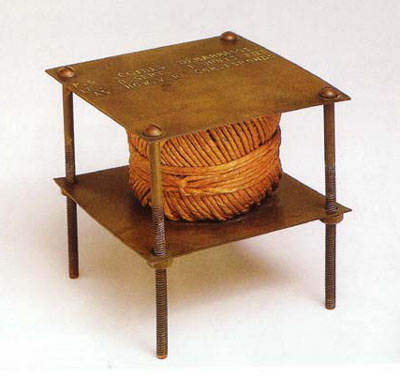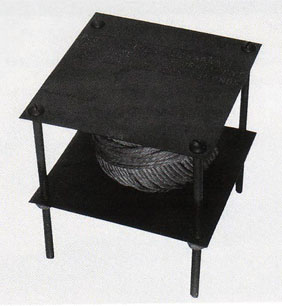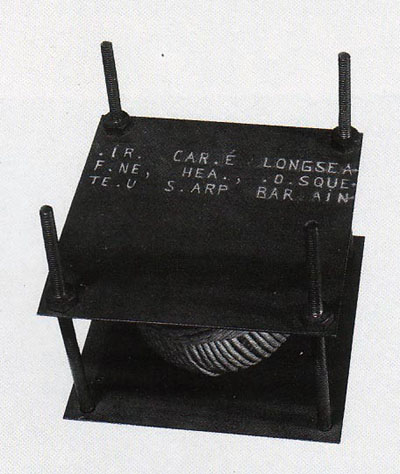
With Hidden Noise
or
A Bruit Secret
 |
| Original version, 1916 |
|
Original Version:
Easter 1916, New York |
This Readymade was a collaborative exercise that Duchamp completed with the help of his friend Walter Arensberg. Duchamp instructed Arensberg to loosen the long screws holding the construction together, place a small object inside the ball of twine, and not inform him or anyone else what it was. What rattles inside when With Hidden Noise is shaken remains a mystery to this day. Duchamp explained in a 1956 interview,
| "Before I finished it Arensberg put something inside the ball of twine, and never told me what it was, and I didn't want to know. It was a sort of secret between us, and it makes noise, so we called this a Ready-made with a hidden noise. Listen to it. I don't know; I will never know whether it is a diamond or a coin" (Sanouillet & Peterson 135). |
As a result, this piece is designed for action and not just to be looked at.
The two brass plates are engraved on the top and bottom with a mysterious inscription ofEnglish and French words. Duchamp compared his manipulation of the letters on this Readymade to "a neon sign when one letter is not lit and makes the word unintelligible" (D'Harnoncourt 280). In a letter to Schwarz, the artist described the inscription as an,
| "exercise in comparative orthography (English-French). The periods must be replaced (with one exception: Debarrasse[e]) by one of the two letters of the other two lines, but in the same vertical as the period - French and English are mixed and make no 'sense.' The three arrows indicate the continuity of the line from the lower plate to the other [upper] still without meaning" (644). |
 |
| Original version, 1916 (Top) |
P.G. ECIDES DEBARRASSEE.These three lines are divided into small rectangles. The inscription on the lower plate is arranged in the same manner:
LE. D.SERT. F.URNIS.ENT
AS HOW.V.R COR.ESPONDS
.IR. CAR.E LONGSEA
F.NE, HEA., .O.SQUE
TE.U S.ARP BAR AIN .
Duchamp claims that the inscription reads (each line starting on the bottom and continuing on the top) as the following:
"Fire. Carre longsea Peg decided debarrasse Fine, cheap, lorsque Les deserts fournissent Tenu sharp bargain As however corresponds"
 |
| Original version, 1916 (Bottom) |
This Readymade may initially seem very different than others, but it really embodies many of the same ideas. It functions as a container of sorts, like Belle Haleine and Paris Air. In the end, this ball of twine is really no more than a single line that doubles back upon itself - just like Duchamp's linguistic acrobatics or the bits of string he dropped to create the Three Standard Stoppages (Joselit 79).
Replicas:
1) 1963, Stockholm
Moderna Museet, Stockholm
Gift of the Moderna Museets Vanner
11.5 x 11.5 x 11.5 cm
2) 1964, Milan
Edition of eight replicas, identical to original, except the lines in cursive script not added and the "hidden object" picked by Alexina Duchamp instead.
Made under supervision of artist from photos of original. Two outside edition reserved for the artist and publisher, and two more for the museum exhibition